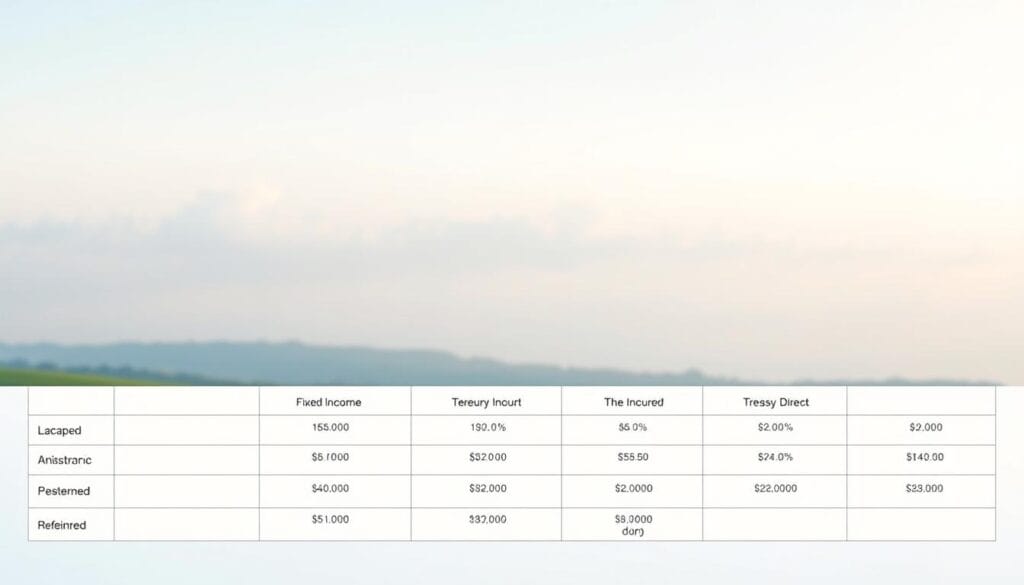Fixed Income for Beginners: How to Choose Between CDBs, Treasury Direct and Others
For those new to investing, fixed income investments can seem daunting. However, they offer a relatively stable way to grow your savings. CDBs and Treasury Direct are two popular options that beginners often consider.
Understanding the differences between these options is crucial for making informed decisions. This article aims to guide you through the process of choosing the right fixed income investment for your needs.
Key Takeaways
- Understand the basics of fixed income investments
- Learn about CDBs and their benefits
- Discover the advantages of Treasury Direct
- Compare CDBs and Treasury Direct
- Make an informed decision based on your financial goals
What Are Fixed Income Investments?
In the realm of investing, fixed income products stand out for their ability to provide consistent returns and reduce overall portfolio risk. Fixed income investments are a vital component of a comprehensive investment strategy, offering investors a way to generate regular income and preserve capital. These investments involve lending money to entities in exchange for periodic interest payments and the eventual return of principal.
The Definition and Purpose of Fixed Income
Fixed income investments are defined by their ability to provide investors with regular income in the form of interest payments. The primary purpose of these investments is to offer a relatively stable source of returns, mitigating the volatility often associated with other investment types. They achieve this by lending to credible borrowers, such as governments or corporations, who promise to repay the principal amount along with interest.

The Role of Fixed Income in a Diversified Portfolio
A diversified investment portfolio typically includes a mix of asset classes to balance risk and potential returns. Fixed income investments play a crucial role in this mix by providing a stabilizing effect. They tend to be less volatile than equity investments, thereby reducing the overall risk profile of the portfolio. By incorporating fixed income investments, investors can create a more resilient portfolio that is better equipped to weather market fluctuations.
Investments, Fixed Income (CDBs, Treasury Direct): Core Principles
The world of fixed income investing is governed by key characteristics and risk-return dynamics. Fixed income investments, including CDBs (Certificates of Deposit) and Treasury Direct, offer investors a range of options for generating regular income.
Key Characteristics That Define Fixed Income
Fixed income investments are defined by several key characteristics, including their risk profile, return expectations, and liquidity.
- Risk Profile: Generally considered lower risk compared to equities.
- Return Expectations: Typically offer fixed returns in the form of interest payments.
- Liquidity: Varies across different types of fixed income investments.
These characteristics make fixed income investments attractive to a wide range of investors, from conservative to those seeking diversification.

Understanding the Risk-Return Relationship
The risk-return relationship is a fundamental concept in fixed income investing. It dictates that higher returns are generally associated with higher risk.
- Low-Risk Investments: CDBs and Treasury securities are considered low-risk.
- Higher-Risk Investments: Corporate bonds and some municipal bonds carry higher risk.
Understanding this tradeoff is crucial for investors to make informed decisions that align with their risk tolerance and investment goals.
Certificates of Deposit (CDs): Safety and Predictability
For investors looking for safety and reliability, Certificates of Deposit (CDs) stand out as a preferred choice in the fixed income market. CDs are time deposits offered by banks with a fixed interest rate and maturity date.
How CDs Function in the American Market
CDs function by allowing investors to deposit a sum of money for a fixed period, during which they earn a fixed rate of interest. They are insured by the FDIC, making them a low-risk investment. The fixed rate and term provide predictability, making it easier for investors to plan.
CD Terms and Early Withdrawal Penalties
CDs come with various term lengths, from a few months to several years. Early withdrawal penalties are imposed if funds are withdrawn before the maturity date. These penalties can vary but often involve forfeiting some of the interest earned.
Current CD Rates and Historical Performance
CD rates vary based on market conditions and the term length chosen. Currently, rates are competitive, with longer-term CDs offering higher rates. Historically, CDs have provided stable returns, although rates have fluctuated over time.
Investors should consider their liquidity needs and financial goals when selecting a CD term. While CDs offer a safe investment, the penalties for early withdrawal can be a drawback.
Treasury Direct: Investing Directly with the Government
Treasury Direct provides a platform for investors to purchase government securities directly, eliminating intermediary costs. This direct investment approach can be particularly appealing to those seeking low-risk investment options.
Setting Up and Using a Treasury Direct Account
To start investing through Treasury Direct, one must first set up an account. This process involves providing personal and financial information and verifying one’s identity. Once the account is established, investors can browse and purchase various government securities, including Treasury Bills, Notes, Bonds, and TIPS.
The process is relatively straightforward, with the Treasury Department providing detailed guidance on its website. Investors can manage their accounts online, including buying securities, checking holdings, and reinvesting matured securities.
Treasury Bills, Notes, Bonds, and TIPS
Treasury Direct offers a variety of government securities, each with its own characteristics and benefits. Treasury Bills (T-Bills) are short-term securities with maturities ranging from a few weeks to a year, sold at a discount to face value. Treasury Notes have longer maturities, ranging from 2 to 10 years, and offer fixed interest payments. Treasury Bonds are long-term investments with maturities up to 30 years, also offering regular interest payments.
TIPS (Treasury Inflation-Protected Securities) are designed to protect investors from inflation by adjusting the principal value based on changes in the Consumer Price Index (CPI). This feature makes TIPS particularly attractive during periods of rising inflation.
| Security Type | Maturity | Interest Payments | Inflation Protection |
|---|---|---|---|
| Treasury Bills | Short-term (up to 1 year) | No | No |
| Treasury Notes | 2 to 10 years | Yes, fixed | No |
| Treasury Bonds | Up to 30 years | Yes, fixed | No |
| TIPS | 5, 10, or 30 years | Yes, adjusted for inflation | Yes |
Safety Features and Liquidity Considerations
Government securities offered through Treasury Direct are backed by the full faith and credit of the U.S. government, making them extremely low-risk investments. However, their liquidity can vary. Treasury Bills and Notes can be sold on the secondary market, but the prices may fluctuate based on market conditions.
Liquidity is an essential consideration for investors who may need to access their funds before the maturity date. While Treasury Direct allows for the sale of securities on the secondary market, it’s crucial to understand that market prices may result in a gain or loss.
In conclusion, Treasury Direct offers a secure and straightforward way to invest in government securities, providing a range of options to suit different investment goals and risk tolerances. By understanding the characteristics of each security type, investors can make informed decisions that align with their financial objectives.
Corporate Bonds: Balancing Yield and Risk
For investors looking to navigate the fixed income landscape, corporate bonds present an opportunity to balance returns with risk management. Corporate bonds are debt securities issued by companies to raise capital, offering investors regular income in the form of interest payments.
Navigating Corporate Bond Ratings
Bond ratings are crucial in assessing the creditworthiness of the issuer. Agencies like Moody’s and Standard & Poor’s provide ratings that help investors understand the risk associated with a particular bond. Higher ratings indicate lower risk, while lower ratings suggest higher risk and potentially higher yields.
How to Purchase Corporate Bonds
Investors can purchase corporate bonds directly through financial institutions or online brokerage platforms. It’s essential to research the issuer’s credit profile and understand the bond’s terms, including its maturity date and interest rate.
Analyzing Yield Spreads and Bond Pricing
Yield spreads and bond pricing are critical factors in evaluating the attractiveness of a corporate bond. Yield spreads reflect the difference in yield between a corporate bond and a comparable government bond, indicating the additional risk premium demanded by investors. Understanding these dynamics helps investors make informed decisions.
Municipal Bonds: Tax-Efficient Investing
The allure of municipal bonds lies in their potential for tax-free income, making them attractive to many investors. Municipal bonds are issued by local governments and other public entities to finance projects such as infrastructure, schools, and hospitals.
Federal and State Tax Advantages
Municipal bonds offer significant tax advantages. The interest earned is often exempt from federal income tax and, in some cases, state and local taxes as well. This tax-exempt status can make municipal bonds particularly appealing to investors in higher tax brackets.
Evaluating Municipal Credit Quality
When investing in municipal bonds, it’s crucial to evaluate the credit quality of the issuer. This involves assessing the issuer’s financial health and ability to meet its debt obligations. Credit rating agencies like Moody’s and Standard & Poor’s provide valuable insights into the creditworthiness of municipal bond issuers.
General Obligation vs. Revenue Bonds
Municipal bonds are broadly categorized into general obligation bonds and revenue bonds. General obligation bonds are backed by the full faith and credit of the issuer, whereas revenue bonds are secured by the revenue generated from a specific project. Understanding the differences between these two types is essential for making informed investment decisions.
Money Market Instruments: Short-Term Fixed Income
For investors seeking liquidity and low risk, money market instruments offer a viable short-term fixed income solution. These instruments are designed to provide a low-risk investment option with returns that are generally higher than those from traditional savings accounts.
Money Market Accounts vs. Money Market Funds
Money market accounts and money market funds are two popular types of money market instruments. While both offer competitive yields and liquidity, they differ in their structure and benefits.
- Money Market Accounts: These are deposit accounts offered by banks, typically with FDIC insurance, providing a low-risk investment option.
- Money Market Funds: These are investment products that pool money from various investors to invest in a diversified portfolio of low-risk, short-term securities.
The choice between the two depends on the investor’s priorities regarding risk, liquidity, and returns.
FDIC Insurance and Risk Considerations
One of the critical factors distinguishing money market accounts from money market funds is the presence of FDIC insurance. Money market accounts are generally insured by the FDIC, protecting deposits up to $250,000 per depositor, per insured bank.
In contrast, money market funds are not insured and carry a risk of loss, although they typically invest in high-quality, short-term securities to minimize this risk.
Fixed Income Funds: Professional Management
Professional management is a key benefit that fixed income funds bring to the table for investors. By pooling resources into a fund managed by experienced professionals, investors can tap into a diversified portfolio of fixed income securities that might otherwise be out of reach.
ETFs vs. Mutual Funds for Fixed Income
When it comes to fixed income funds, investors have a choice between Exchange-Traded Funds (ETFs) and mutual funds. ETFs offer the flexibility of trading throughout the day, while mutual funds are traded at the end of the day based on their net asset value. Both have their advantages, with ETFs providing liquidity and mutual funds often having lower minimum investment requirements.
Active vs. Passive Fixed Income Management
The debate between active and passive management is ongoing in the fixed income space. Active management involves fund managers actively selecting securities to try and outperform the market, potentially offering higher returns but often at a higher cost. In contrast, passive management aims to replicate the performance of a specific index, typically with lower fees. The choice between the two depends on the investor’s goals and risk tolerance.
Understanding Expense Ratios and Their Impact
Expense ratios are a critical factor in the performance of fixed income funds. They represent the percentage of fund assets used to cover operational costs. A lower expense ratio means less of the investor’s return is eaten away by fees. For instance, a fund with a 0.5% expense ratio will consume $5 of every $1,000 invested annually. Investors should carefully consider the expense ratio when selecting a fixed income fund, as it directly impacts their net returns.
- Key Considerations:
- Investment goals and risk tolerance
- Fund management style (active vs. passive)
- Expense ratios and their impact on returns
Side-by-Side Comparison: Choosing the Right Fixed Income Investment
Selecting the ideal fixed income investment requires a thorough comparison of characteristics such as liquidity, safety, yield, tax efficiency, and minimum investment requirements. Different investments prioritize these factors differently, impacting their suitability for various investor needs.
Liquidity: When You Need Your Money Back
Liquidity refers to how easily an investment can be converted into cash without affecting its value. Investments like money market funds offer high liquidity, whereas certificates of deposit (CDs) may impose penalties for early withdrawal.
- High liquidity: Money market funds, Treasury bills
- Low liquidity: CDs, certain bonds
Safety: Protecting Your Principal
Safety is about preserving the initial investment. Government-backed securities like Treasury bonds and FDIC-insured CDs are generally considered safe.
- High safety: Treasury bonds, FDIC-insured CDs
- Variable safety: Corporate bonds, depending on issuer creditworthiness
Yield: Maximizing Your Returns
Yield is the return an investor can expect from a fixed income investment. Generally, higher yields come with higher risks. Corporate bonds often offer higher yields than government bonds.
- Higher yield: Corporate bonds, some municipal bonds
- Lower yield: Treasury bills, money market accounts
Tax Efficiency: Keeping More of What You Earn
Tax efficiency is crucial for maximizing net returns. Investments like municipal bonds can offer tax-free income, particularly for investors in higher tax brackets.
- Tax advantages: Municipal bonds
- Taxable: Corporate bonds, CDs
Minimum Requirements and Accessibility
The minimum investment required can vary significantly. For instance, Treasury Direct allows investments with a minimum of $100, while some mutual funds may require more substantial initial investments.
- Low minimum: Treasury Direct, some money market funds
- Higher minimum: Certain mutual funds, managed accounts
Building Your Fixed Income Strategy by Age and Goal
As investors journey through different life stages, their fixed income strategies must adapt to meet changing financial goals and risk tolerance.
Developing a fixed income strategy that aligns with one’s age and financial objectives is crucial for achieving long-term financial stability. This involves understanding the various fixed income options available and how they can be tailored to meet individual needs at different life stages.
Starting Out: Fixed Income for Young Investors
For young investors, the focus is on building a foundation for long-term financial stability. This can involve starting with low-risk fixed income investments such as high-yield savings accounts or short-term CDs, which provide liquidity while generating returns.
Young investors can also consider allocating a portion of their portfolio to treasury bills or money market funds, which offer a low-risk entry point into fixed income investing.
Mid-Life: Balancing Growth with Stability
As investors reach mid-life, their financial goals often shift towards balancing growth with stability. At this stage, investors may consider diversifying their fixed income portfolio by incorporating corporate bonds or municipal bonds, which can offer higher yields and tax advantages, respectively.
This stage is also critical for assessing risk tolerance and adjusting the fixed income strategy accordingly. Investors may need to balance their desire for returns with the need to protect their capital.
Retirement Planning: Income Generation and Preservation
For those planning for retirement, the focus shifts towards generating a stable income stream and preserving capital. Investors may consider allocating a larger portion of their portfolio to fixed income securities such as government bonds or annuities, which can provide predictable returns.
It’s also essential to consider the impact of inflation on fixed income investments during retirement. Investors may need to incorporate TIPS (Treasury Inflation-Protected Securities) or other inflation-protected instruments into their portfolios to maintain purchasing power.
Conclusion: Taking Action on Fixed Income Investments
Fixed income investments play a crucial role in achieving financial stability and securing long-term goals. By understanding the various options available, such as CDBs, Treasury Direct, corporate bonds, and municipal bonds, investors can make informed decisions that align with their risk tolerance and financial objectives.
Creating an effective investment action plan involves assessing your financial situation, determining your investment horizon, and selecting the right mix of fixed income investments. This plan should be tailored to your specific needs, whether you’re a young investor starting out or nearing retirement.
By taking a thoughtful and informed approach to fixed income investments, you can build a stable financial foundation. Now is the time to review your investment strategy and make adjustments as needed to ensure you’re on track to meet your financial goals.
Developing a comprehensive investment action plan is essential to maximizing the benefits of fixed income investments. With a clear plan in place, you’ll be better equipped to navigate the complexities of the investment landscape and achieve long-term financial success.
FAQ
What are the key differences between CDBs and Treasury Direct?
How do I choose between fixed income investments based on my risk tolerance?
What is the role of fixed income investments in a diversified portfolio?
How do I evaluate the credit quality of municipal bonds?
What are the benefits of investing in Treasury Bills, Notes, and Bonds?
How do I navigate corporate bond ratings?
What is the difference between money market accounts and money market funds?
How do I choose between ETFs and mutual funds for fixed income investments?
What are the tax implications of investing in municipal bonds?
How do I build a fixed income strategy tailored to my age and financial goals?
Share this content:


Post Comment